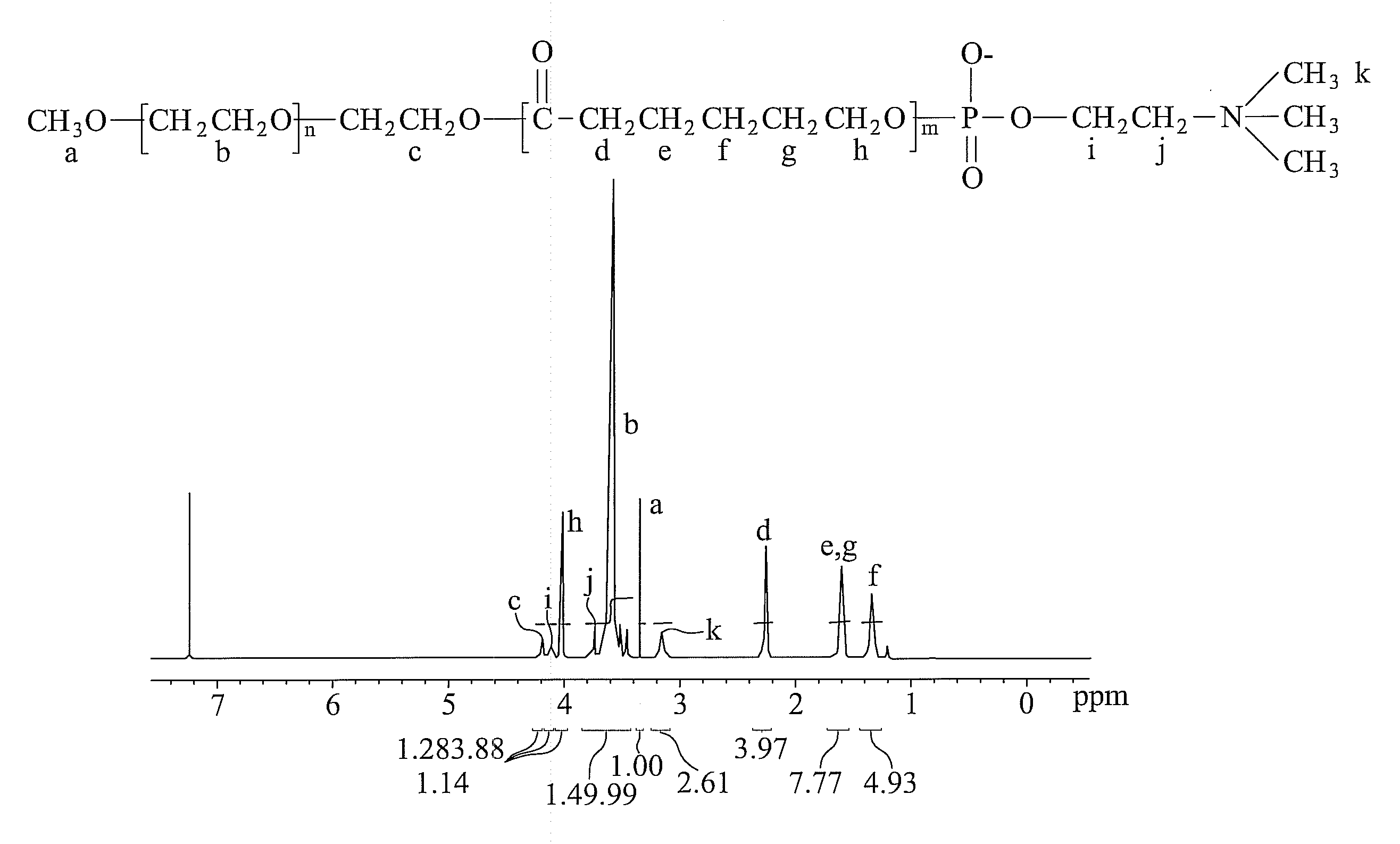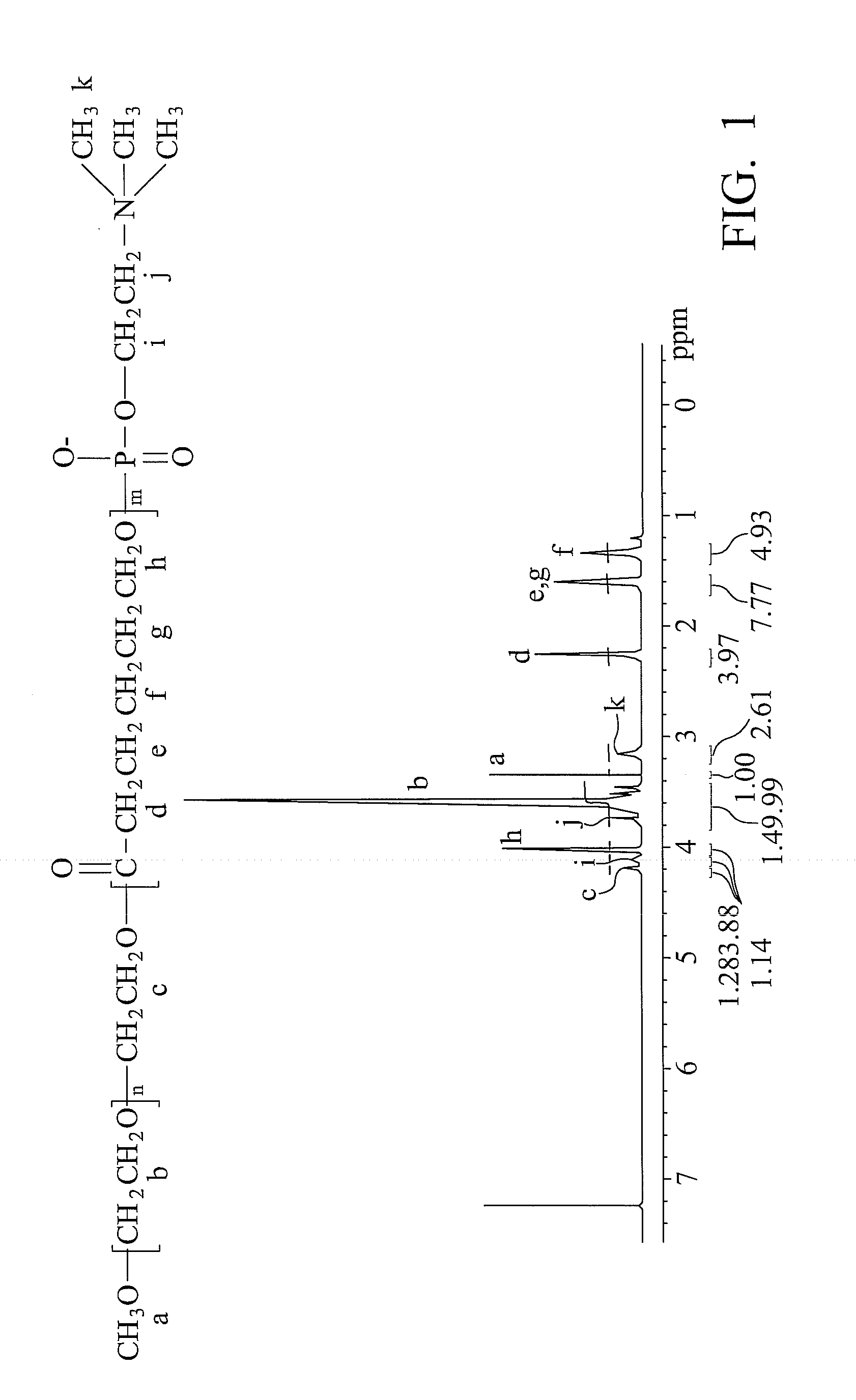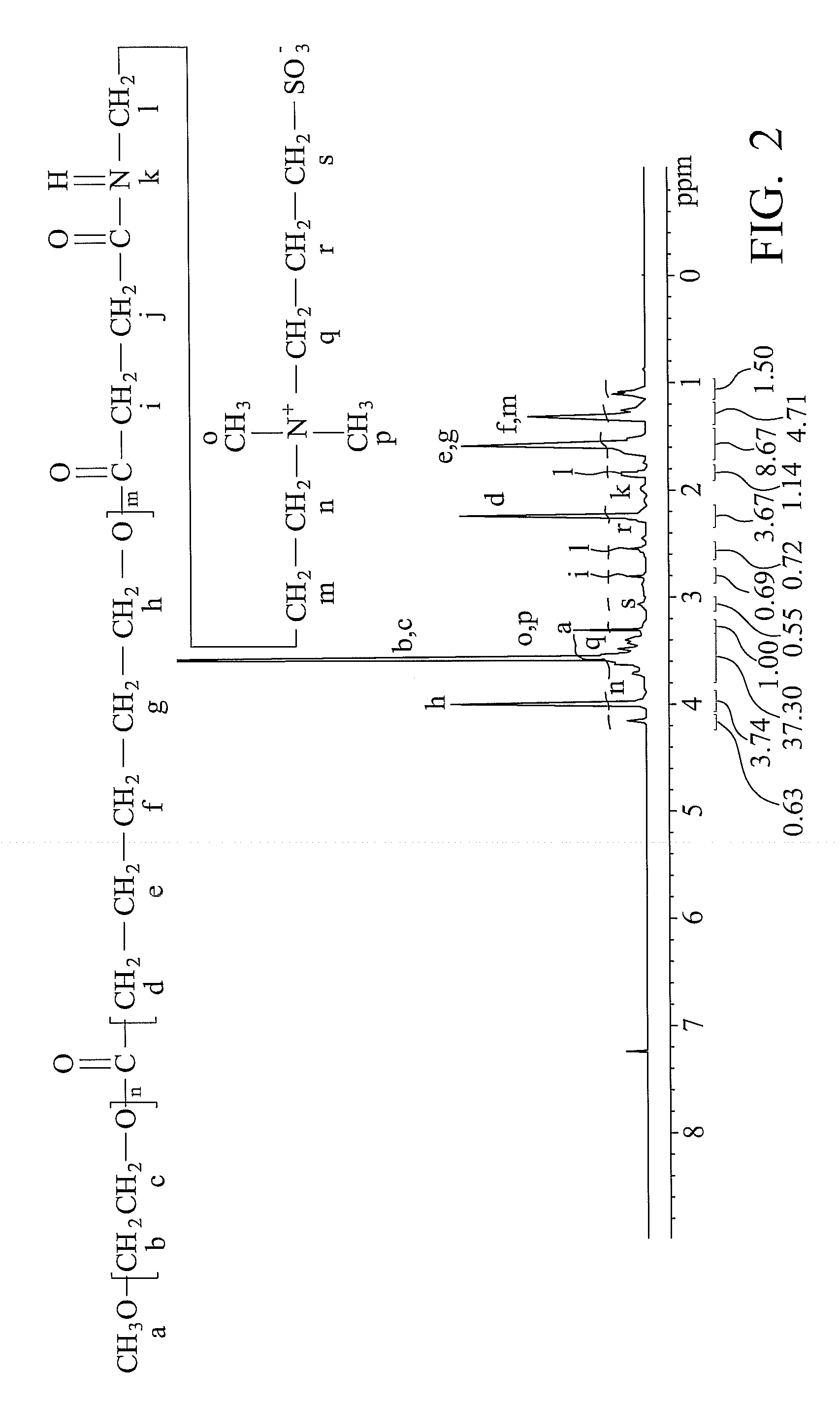Amphiphilic block copolymers and nanoparticles comprising the same
a technology of amphiphilic block and nanoparticles, applied in the field of polymer, can solve the problems of material, lack of biodegradability, long term stability, etc., and achieve the effect of reducing the number of polymers
- Summary
- Abstract
- Description
- Claims
- Application Information
AI Technical Summary
Benefits of technology
Problems solved by technology
Method used
Image
Examples
example 1
Synthesis of PEG-PCL-PC
[0036]
[0037](1) Polymerization of PEG-PCL:
[0038]60 g poly(ethylene glycol) (PEG, 5000 g / mole) and 12 g ε-caprolactone were added to a 250 ml glass reactor (8 cm×8 cm×10 cm) with gradual heating until totally dissolved. The PEG-PCL polymerization then began by adding 0.38 mL catalyst of stannous 2-ethylhexanoate at 160° C. for 24 hours. Dissolving in dichloromethane and re-precipitating in diethyl ether purified the crude product. The purification was repeated three times and vacuum-dried at 40° C. for 24 hours. Thus, a PEG-PCL copolymer was obtained.
[0039](2) Synthesis of PEG-PCL-COP:
[0040]5 g PEG-PCL copolymer and 0.43 g triethylamine (TEA) were dissolved in 70 ml dichloromethane at 0° C. with mechanical stirring in a 250 ml flask. Another solution containing 3.5 g 2-chloro-2-oxo-1,3,2-dioxaphospholane (COP) dissolved in 30 ml dichloromethane was prepared simultaneously. The COP-containing solution was then gradually dropped into the flask within 1 hour and r...
example 2
Synthesis of PEG-PVL-PC
[0043]
[0044](1) Polymerization of PEG-PVL:
[0045]60 g poly(ethylene glycol) (PEG, 5000 g / mole) and 12 g δ-valerolactone were added to a 250 ml glass reactor (8 cm×8 cm×10 cm) with gradual heating until totally dissolved. The PEG-PVL polymerization then began by adding 0.38 ml catalyst of stannous 2-ethylhexanoate at 160° C. for 8 hours. The result was dissolved in dicholomethane and re-precipitated by adding diethyl ether. The white precipitate was then washed three times and vacuum-dried at 40° C. for 24 hours. Thus, a PEG-PVL copolymer was obtained.
[0046](2) Synthesis of PEG-PVL-COP:
[0047]5 g PEG-PVL copolymer and 0.43 g triethylamine (TEA) were dissolved in 70 ml dichloromethane at 0° C. by mechanical stirring in a 250 ml flask. Another solution containing 3.5 g 2-chloro-2-oxo-1,3,2-dioxaphospholane (COP) dissolved in 30 ml dichloromethane was prepared simultaneously. The COP-containing solution was then gradually added to the flask over 1 hour and reacted a...
example 3
Synthesis of PEG-PCL-NS
[0050]
[0051](1) Synthesis of PEG-PCL-SA:
[0052]3 g PEG-PCL copolymer and 0.1 g 4-dimethylaminopyridine (DMAP) were dissolved in 60 ml dichloromethane at 0° C. with mechanical stirring in a 250 ml flask. Another solution containing 0.1 g triethylamine (TEA) and 0.5 g succinic anhydride (SA) dissolved in 10 ml dichloromethane was prepared simultaneously. The SA-contained solution was then gradually dropped into the flask within 1 hour and reacted at 25° C. for 24 hours. The resulting solution was then precipitated three times by adding diethyl ether and vacuum-dried for 24 hours. Thus, a modified copolymer, PEG-PCL-SA, was obtained.
[0053](2) Synthesis of PEG-PCL-TA:
[0054]2 g PEG-PCL-SA copolymer, 0.2 g 1,3-dicyclohexylcarbodimide (DCC), and 0.1 g N-hydroxysuccinimide (NHS) were dissolved in 40 ml dichloromethane at 0° C. with mechanical stirring in a 250 ml flask. Another solution containing 0.1 g 3-(dimethylamino)propylamine (DMAPA) dissolved in 10 ml dichlorome...
PUM
| Property | Measurement | Unit |
|---|---|---|
| diameter | aaaaa | aaaaa |
| diameter | aaaaa | aaaaa |
| particle size distribution | aaaaa | aaaaa |
Abstract
Description
Claims
Application Information
 Login to View More
Login to View More - R&D
- Intellectual Property
- Life Sciences
- Materials
- Tech Scout
- Unparalleled Data Quality
- Higher Quality Content
- 60% Fewer Hallucinations
Browse by: Latest US Patents, China's latest patents, Technical Efficacy Thesaurus, Application Domain, Technology Topic, Popular Technical Reports.
© 2025 PatSnap. All rights reserved.Legal|Privacy policy|Modern Slavery Act Transparency Statement|Sitemap|About US| Contact US: help@patsnap.com



